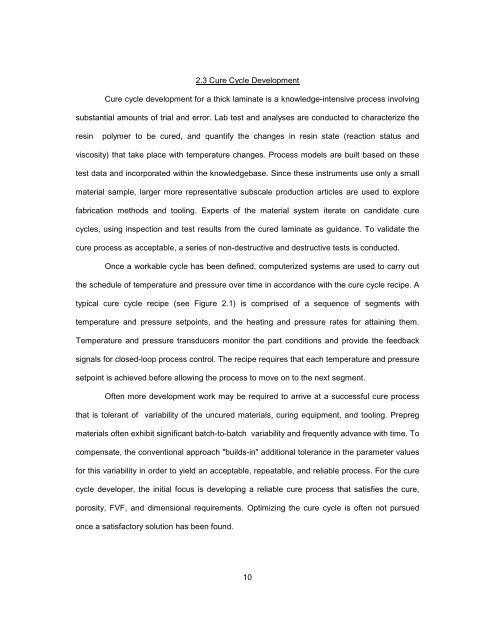TOOLED THICK COMPOSITES by ARVEN H. SAUNDERS III ...
TOOLED THICK COMPOSITES by ARVEN H. SAUNDERS III ...
TOOLED THICK COMPOSITES by ARVEN H. SAUNDERS III ...
Create successful ePaper yourself
Turn your PDF publications into a flip-book with our unique Google optimized e-Paper software.
2.3 Cure Cycle Development<br />
Cure cycle development for a thick laminate is a knowledge-intensive process involving<br />
substantial amounts of trial and error. Lab test and analyses are conducted to characterize the<br />
resin polymer to be cured, and quantify the changes in resin state (reaction status and<br />
viscosity) that take place with temperature changes. Process models are built based on these<br />
test data and incorporated within the knowledgebase. Since these instruments use only a small<br />
material sample, larger more representative subscale production articles are used to explore<br />
fabrication methods and tooling. Experts of the material system iterate on candidate cure<br />
cycles, using inspection and test results from the cured laminate as guidance. To validate the<br />
cure process as acceptable, a series of non-destructive and destructive tests is conducted.<br />
Once a workable cycle has been defined, computerized systems are used to carry out<br />
the schedule of temperature and pressure over time in accordance with the cure cycle recipe. A<br />
typical cure cycle recipe (see Figure 2.1) is comprised of a sequence of segments with<br />
temperature and pressure setpoints, and the heating and pressure rates for attaining them.<br />
Temperature and pressure transducers monitor the part conditions and provide the feedback<br />
signals for closed-loop process control. The recipe requires that each temperature and pressure<br />
setpoint is achieved before allowing the process to move on to the next segment.<br />
Often more development work may be required to arrive at a successful cure process<br />
that is tolerant of variability of the uncured materials, curing equipment, and tooling. Prepreg<br />
materials often exhibit significant batch-to-batch variability and frequently advance with time. To<br />
compensate, the conventional approach "builds-in" additional tolerance in the parameter values<br />
for this variability in order to yield an acceptable, repeatable, and reliable process. For the cure<br />
cycle developer, the initial focus is developing a reliable cure process that satisfies the cure,<br />
porosity, FVF, and dimensional requirements. Optimizing the cure cycle is often not pursued<br />
once a satisfactory solution has been found.<br />
10
















